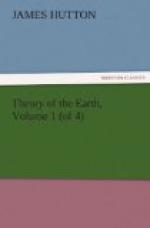It must not be alleged, that the heights of the Oural mountains, or the hardness of their rocks, make an essential distinction between them and the argillaceous or arenaceous strata of the plains; solidity and hardness, as well as changes in their height and natural position, has been superinduced in operations posterior to the collection of those masses,—operations which may be formed in various degrees, even in the different parts of the same mass. If this is the case, there can be no difficulty in conceiving a stratum, which appears to be argillaceous or marly in the plains, to be found jasper in the Oural mountains. But there is nothing in the Oural mountains, that may not be found some where or other in the plains, although the soft and easily decomposing argillaceous strata be not found upon the Oural mountains, or the Alps, for this reason, that had those mountains been formed of such materials, there had not been a mountain there at this day.
But surely the greatest possible error, with regard to the philosophy of this earth, would be to confound the sediment of a river with the strata of the globe; bodies deposited upon the surface of the earth, with those sunk at the bottom of the sea; and things which only form the travelled or transported soil, with those which constitute the substratum or the solid earth. How far M. Pallas has committed this oversight, I leave others to determine. After mentioning those strata in which wood is found petrified, and metallic minerals formed, he thus proceeds, (page 69).
“Dans ces memes depots sableux et souvent limoneux, gisent les restes des grands animaux de l’Inde: ces ossemens d’elephans, de rhinoceros, de buffles monstrueux, dont on deterre tous les jours un si grand nombre, et qui font l’admiration des curieux. En Siberie, ou l’on a decouvert le long de presque toutes les rivieres ces restes d’animaux etrangers, et l’ivoire meme bien conserve en si grande abondance, qu’il forme un article de commerce, en Siberie, dis je, c’est aussi la couche la plus moderne de limon sablonneux qui leur sert de sepulture, et nulle part ces monumens etrangers sont si frequens, qu’aux endroits ou la grande chaine, qui domine surtout la frontiere meridionale de la Siberie, offre quelque depression, quelque ouverture considerable.
“Ces grands ossemens, tantot epars tantot entasses par squelettes, et meme par hecatombes, consideree dans leurs sites naturels, m’ont sur-tout convaincu de la realite d’un deluge arrive sur notre terre, d’une catastrophe, dont j’avoue n’avoir pu concevoir la vraisemblance avant d’avoir parcouru ces places, et vu, par moi-meme, tout ce qui peut y servir de preuve a cet evenement memorable[24]. Une infinite de ces ossemens couches dans des lits meles de petites tellines calcinees, d’os de poissons, de glossopetres, de bois charges d’ocre, etc. prouve deja qu’ils ont ete transportes par des inondations. Mais la carcasse d’un rhinoceros, trouve avec sa peau entiere, des restes




